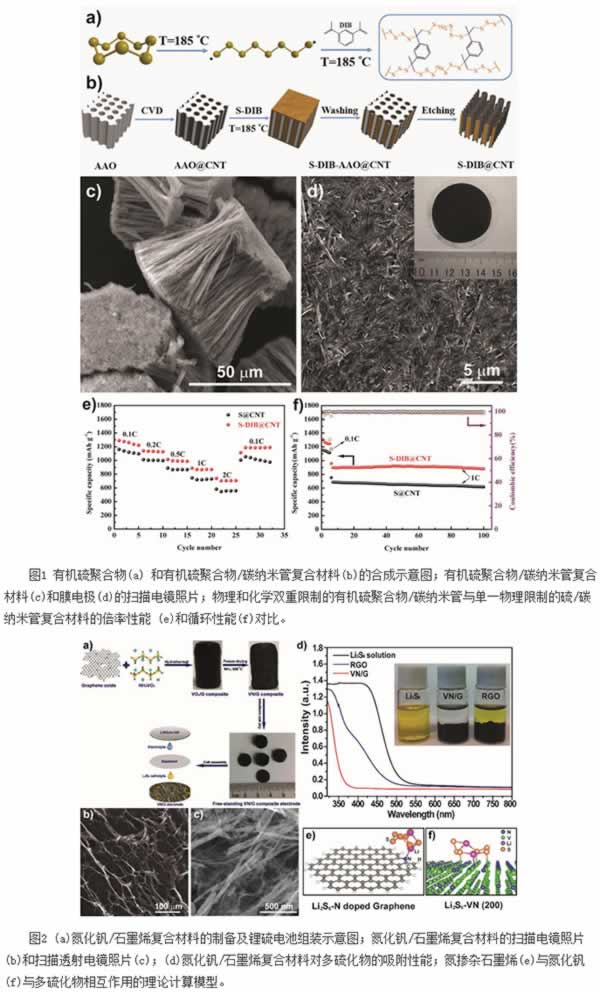Sulfur as a cathode material has a high theoretical specific capacity (an order of magnitude higher than that of existing commercial cathode materials), and also has the advantages of low cost, abundant reserves, and environmental friendliness, and thus lithium-sulfur batteries are considered to be electrochemical. One of the most promising next-generation batteries in energy storage. However, in the process of practical application of lithium-sulfur batteries, there are still many problems to be solved, such as the low conductivity of sulfur and lithium sulfide as a discharge product, and the shuttle effect of soluble polysulfides formed between charge and discharge during positive and negative electrodes. , will significantly affect the battery's rate performance and cycle life. In order to solve these problems, a multi-component composite electrode can be formed by introducing guest materials (such as carbon materials, metal oxides, and nitrides) into the electrode material to utilize the high conductivity of the guest material and the adsorption of polysulfides. Limit the role of inhibiting the shuttle effect, thereby improving the performance of lithium-sulfur batteries.
Recently, a series of research work on high-performance multi-component composite sulfur electrode materials has been carried out by the Research Group of Energy Storage Materials and Devices of the Advanced Carbon Materials Research Division of the National (United) Laboratory of Materials Science at the Institute of Metal Research, Chinese Academy of Sciences. Firstly, they used density functional theory calculations. Using nitrogen-doped graphene as a model, it was found that the pyridine nitrogen clusters can strongly adsorb polysulfide molecules in different nitrogen-doped forms, and proposed the component and polysulfide. The energy interaction relationship of the matter interaction. On this basis, nitrogen-doped graphene with excellent electrochemical performance and high nitrogen content was obtained by high temperature treatment of graphene oxide with ammonia gas. In order to further increase the limiting effect on polysulfides, the physical limitation of carbon nanotubes on polysulfides is combined with the chemical restriction of carbon-sulfur bonds on polysulfides in organosulfur polymers, and organic sulfur polymers are loaded. An organic sulfur polymer/carbon nanotube composite was prepared from carbon nanotubes synthesized by anodized aluminum as a template ( FIG. 1 ). The composite material physically restricts the polysulfide dissolution through the lumen of the carbon nanotubes, and simultaneously utilizes the carbon-sulfur bond in the organic sulfur polymer to chemically fix the sulfur, synergistically inhibiting the polysulfide shuttle effect.
However, for a non-polar carbon material, its effective adsorption to polar polysulfide cannot be further improved even by a treatment such as doping, so that it is difficult to completely suppress the shuttle effect. Theoretical calculations show that the effect of using polar oxides to chemisorb polysulfides and suppress the shuttle effect is significantly better than carbon materials. However, insulative oxides can hinder the transmission of electrons and lithium ions and reduce the utilization and rate performance of sulfur. How to combine the characteristics of the two to find the highly conductive polar adsorbent has become the core of the research. To this end, the researchers proposed the idea of ​​constructing carbon-based composite electrodes with chemically anchored polysulfides, combining carbon nanomaterials with highly conductive metal nitrides with chemically anchored polysulfide functions, using one-step hydrothermal The vanadium nitride nanoribbons were loaded on a three-dimensional graphene base, and lithium polysulfide was used as an active material to fill the three-dimensional channels of the current collector of graphene and vanadium nitride composites (as shown in FIG. 2 ). This composite positive electrode structure not only makes full use of the three-dimensional framework and pore structure of graphene, but also combines the chemisorption and transformation promotion effect of highly conductive polar vanadium nitride on polysulfides, effectively solving the problem of "shuttle effect". From the problems of capacity decay and low Coulomb efficiency, excellent electrochemical performance was obtained. Compared to a single graphene electrode, the vanadium nitride/graphene composite electrode has smaller polarization and faster redox reaction kinetics, showing better rate and cycling performance, and may be used in the application of high-energy lithium-sulfur batteries. Has great potential. At the same time, metal nitrides are a large family, and their high conductivity and chemical polarity characteristics can provide new options for related electrochemical applications.
The relevant papers based on the above research results were published in Nano Energy 2016 (25, 203-210), Carbon 2016 (108, 120-126), and Advanced Materials DOI (10.1002/). Adma.201603835) and Nature Communication DOI: 10.1038/ncomms14627. The above work was supported by the National Key R&D Program, the National Natural Science Fund Project, the Pilot Project of the Chinese Academy of Sciences, the Young Innovation Promotion Association of the Chinese Academy of Sciences and the Innovation Fund Project of the Metal Institute.

Deforming Agent,Defoamer Agent,Antifoaming Agents,Oil Based Defoamers
Shanghai Na Long Tech Co., Ltd , https://www.na-long.com